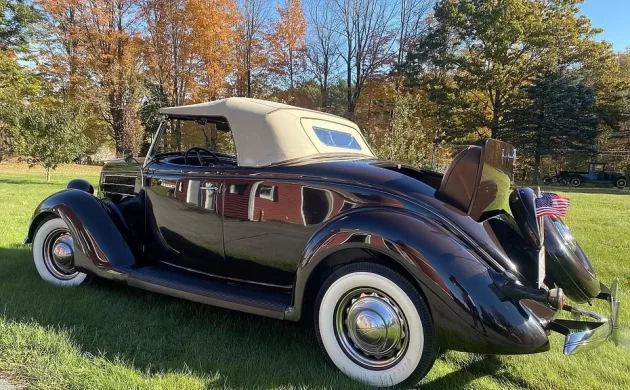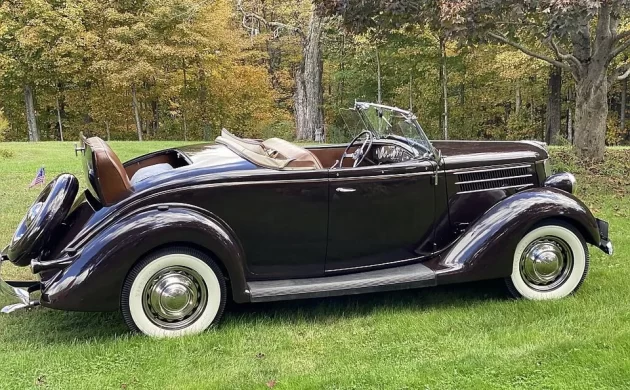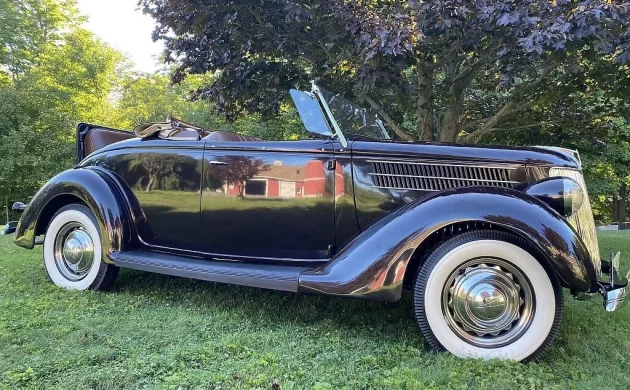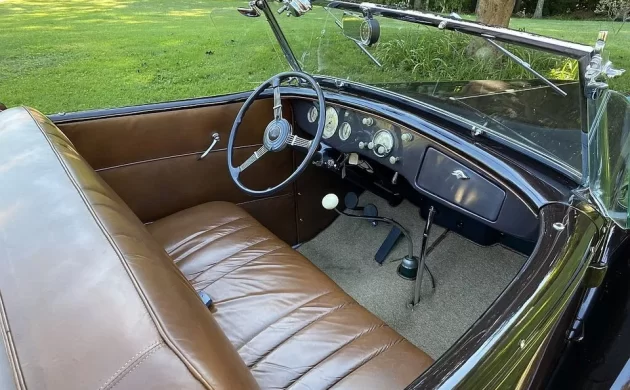Anyone who has completely restored a classic car can tell you that the process always requires a lot of money, time, and parts. Finding good parts can be the most frustrating part of the process. Sometimes the parts you need are on a parts car, some are bought used, some are reproductions, and a precious few are NOS (new old stock). NOS parts are always preferred, but they are usually in short supply and the prices are high. The upside is that the finished product is greatly enhanced by using unused parts made by the original manufacturer. This 1936 Ford roadster for sale on eBay in Templeton, Massachusetts is a perfect example of a car restored when NOS parts were readily available and restorers took great pride in the finished product. Sitting at a current bid of $36,903, is that above-market number reflective of the car’s true value?
Before we move further, perhaps a more extensive definition of New Old Stock is warranted. While today’s consumer almost always shops for auto parts online or at a local chain auto parts store, the normal process decades ago was to travel to the dealer that represented the make of car you were working on. Dealerships would carry an exhaustive amount of parts, and what they didn’t have on hand was ordered and shipped to them to sell to you. Over time, these new parts build up until they are sold off or discarded. When sales fell off because folks had moved on to newer cars, these leftovers would be purchased for pennies on the dollar by middlemen and sold bit by bit from there.
After a while, those parts would filter down to restorers through resellers and swap meets. For those of you new to the game, swap meets were glorious affairs where you would get up unreasonably early, gather up your cronies, drive for an hour or two to a fairgrounds or meeting space of some sort, and spend the day sifting through boxes and haggling for parts. The internet hadn’t been invented yet, so interaction with characters of all descriptions was needed. Today, there are few swap meets left that compare to the ones back in the day. Perhaps only Hershey and Carlisle still carry on the tradition to a comparable scale. If you missed out on this, I feel sorry for you. It was one of the more enjoyable aspects of the hobby.
Once procured, these parts were proudly used on your restoration to make your car or truck the finest possible. The prices on these parts were, as a rule, still reasonable as long as they didn’t have a hen’s teeth level of rarity. You have to also factor in that early restorers of vehicles such as this 1936 Ford roadster usually started with a great example. Any vehicle that was in questionable condition ended up being a parts car unless it was a rare body style. A solid car combined with NOS parts where necessary almost always resulted in an excellent finished product if the restorer was competent. Reproduction parts finally started to show up when NOS parts ran out. As we all know, the quality of these reproductions can vary wildly.
The above scenario is why you will see older restorations like this one bring above-market value when they change hands. Those who are bidding on this car understand that there will be few surprises when the car is purchased. The parts will be from the original manufacturer, and the only disappointments will be those related to the age of the finish and upholstery and any mechanical maladies that have arisen from being in storage for a long time. If you want a keeper and can look past blemishes in the paint and the smell of mothballs, this Ford should be high on your list.
The seller has done an excellent job of describing the attributes of this car. It carries desirable parts such as a rearview mirror with a clock, a factory radio, and the seldom-seen aluminum cylinder heads that invariably got replaced with cast iron heads when the Flathead V-8 engine inevitably overheated. There is also an exhaustive set of pictures farther down in the ad to document every positive and negative about the car. Then, if that wasn’t enough, there are videos to view as well. The car is said to be fully ready for the road and the seller invites you to bring an expert on Ford automobiles of this vintage for an inspection.
In short, this is the type of car that rarely gets sold publicly. Cars like this are usually traded quietly among insiders in organizations like the Early Ford V-8 Club of America and Antique Automobile Club of America. If you have the means and are a fan of Flathead Fords, it doesn’t get much better than this.








Great car. Great write-up. Sadly swap meets are not nearly the event they used to be. I remember the excitement and anticipation, the same way an 11 yr. old boy would look to that first motorcycle ride.
The paint is over the top beautiful!!! You could read the date on a dime in it. Too many cars so little time space and money.GLWTS
Is this the same car that was just sold on Hemmings?
Beautiful write-up,Jeff.Brought me back to the 70s,going to H-D swap meets in the prettiest towns in N.E. Thank You
Oh, yeah swap meets were fun. Especially when you hit pay dirt and found the elusive part that had alluded you for years. We are lucky here in the Mid Atlantic area. We have Carlisle and Hershey. I still go sometimes even though I’m not hunting parts so much anymore. The car corral alone is worth the trip. Not very much stuff at local meets today but you never know. Beautiful car. Wish I could buy it.
Amazing example. Great explanation of how things have changed.
I remember being dragged all over Carlisle and Hershey in the late 80’s looking for parts. My dad was restoring a 36 Ford at the time. Although it was a 5 window coup. Great memories.
Sweet !
I went to Carlisle only a couple of times, but the 2 times I went were exciting, informative & educational.
At the time I had just started in the hobby with my 1972 Buick Riviera in a light mist green.
A vendor was selling Christmas cards and low and behold he had cards with my car on it. A 1972 Buick Riviera in light mist green with Santa driving it! I bought every box he had.
Hi. I’m trying to locate a 36 Ford my uncle restored. Chick Blais of Auburn MA. Whoever now own the car, I would like to pass along a notebook of the restoration. This car looks just like the photos